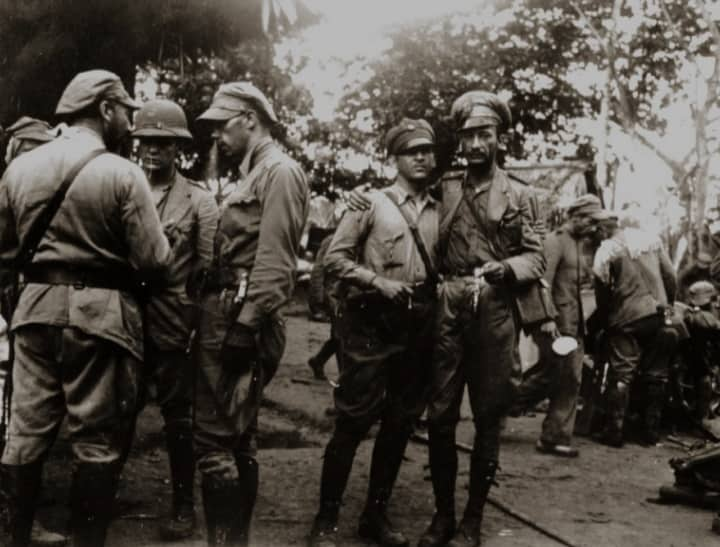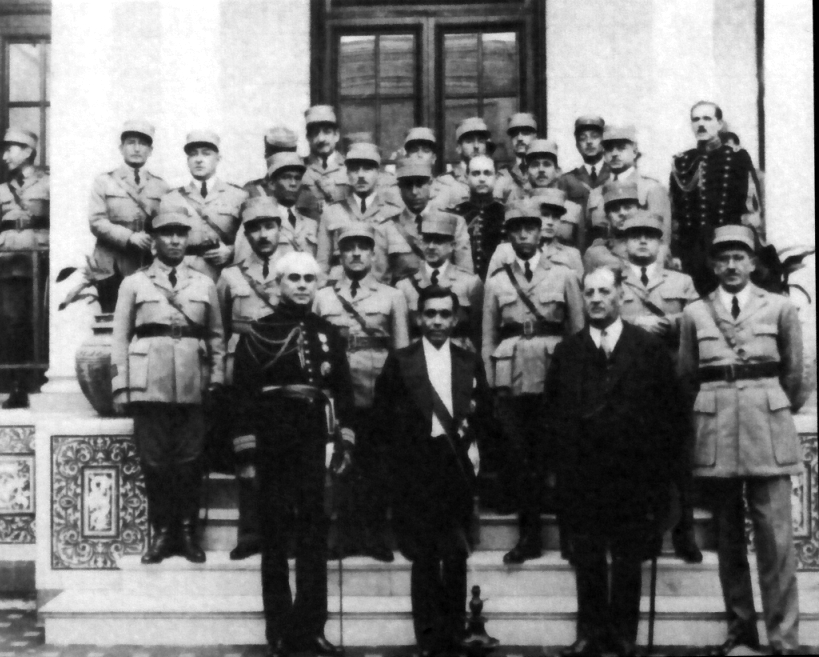|
Assassination Of Luis Miguel Sánchez Cerro
On April 30, 1933, Luis Miguel Sánchez Cerro, then president of Peru, was assassinated while riding in his presidential convertible at the Hipódromo de Santa Beatriz, Santa Beatriz racetrack in Santa Beatriz, a neighbourhood of Lima, Peru. Sánchez Cerro was accompanied by Prime Minister , Chief of Military Staff Antonio Rodríguez Ramírez and his aide-de-camp, Major Eleazar Atencio, when he was fatally shot by American Popular Revolutionary Alliance, APRA militant Abelardo Mendoza Leyva. Sánchez Cerro was rushed to the Italian Hospital where he was pronounced dead two hours later. Also killed in the attack was Mr. Rodríguez Pisco, a member of the Republican Guard (Peru), Republican Guard who had attempted to protect the president. Sánchez Cerro was immediately replaced by Óscar R. Benavides as president after he was elected by Congress of Peru, Congress. As head of the Revolutionary Union (Peru), Revolutionary Union, his political party, he was replaced by Luis A. Flores. T ... [...More Info...] [...Related Items...] OR: [Wikipedia] [Google] [Baidu] |
Hipódromo De Santa Beatriz
The Hippodrome of Santa Beatriz () was a hippodrome located in Jesús María District, Lima, Peru. Now almost completely demolished, its former premises are now occupied by El Campo de Marte. History The concession for a 99-year emphyteusis was granted by the Municipality of Lima in the estate (''fundo'') of the same name at the request of the Lima Jockey Club (LJC) during the late 19th century, in exchange for some territory owned by the club in downtown Lima. The Moorish Revival racecourse was then inaugurated in July of 1903 under the tenure of Alfredo Benavides Diez-Canseco (then president of the LJC), operating until 1938, with its golden age coinciding with the Centennial of the Independence of Peru (and that of the Battle of Ayacucho), from 1921 to 1924. The opening ceremony held in 1903 featured important guests, such as mayor Federico Elguera, who delivered a speech to the packed tribunes, and María Diez Canseco de Benavides (the "godmother" of the ceremony), who br ... [...More Info...] [...Related Items...] OR: [Wikipedia] [Google] [Baidu] |
Colombia–Peru War
The Colombia–Peru War, also called the Leticia War, was a short-lived armed conflict between Colombia and Peru over territory in the Amazon rainforest that lasted from September 1, 1932, to May 24, 1933. In the end, an agreement was reached to divide the disputed area between both countries. The conflict was rooted in the Boundary Treaty of March 24, 1922, which transferred the Leticia district to Colombia, giving Colombia access to the Amazon river. The district was mostly inhabited by Peruvians, which fueled grievances among Peruvians and led them to seek to modify the treaty. Background Civilian takeover The Colombia–Peru War was the result of dissatisfaction with the Salomón–Lozano Treaty and the imposition of heavy tariffs on sugar. The National Patriotic Junta (), known also as the Patriotic Junta of Loreto (), was created on August 27, 1932, by Peruvian civilians Oscar Ordoñez and Juan La Rosa Guevara, in the presence of Lieutenant Colonel Isauro Calderón, Lieu ... [...More Info...] [...Related Items...] OR: [Wikipedia] [Google] [Baidu] |
El Campo De Marte
The Campo de Marte, also known as the Plaza de la Revolución, is a public park in Jesús María District, Lima, Peru. It is one of the largest parks in the metropolitan area of the city, and similar in size to the Park of the Exhibition and the Park of the Reserve. It was originally part of the Santa Beatriz area of Lima District and, from 1903 to 1938, housed the Santa Beatriz Hippodrome until its replacement by the one in San Felipe estate, located further south in the district. The racetrack was eventually paved over with asphalt and given the street name Peruvianness Avenue (). The stands, which remained after the racecourse was disestablished, are currently used for spectators watching the Great Military Parade of Peru, held annually on July 29, the day after Independence Day. Considered the "lung" of the district (and the city), it is located near the headquarters of a number of government institutions, including the National Office of Electoral Processes, the min ... [...More Info...] [...Related Items...] OR: [Wikipedia] [Google] [Baidu] |
Luis Miguel Sánchez Cerro, Hipódromo De Santa Beatriz - 30 De Abril De 1933 (01)
Luis is a given name. It is the Spanish form of the originally Germanic name or . Other Iberian Romance languages have comparable forms: (with an accent mark on the i) in Portuguese and Galician, in Aragonese and Catalan, while is archaic in Portugal, but common in Brazil. Origins The Germanic name (and its variants) is usually said to be composed of the words for "fame" () and "warrior" () and hence may be translated to ''famous warrior'' or "famous in battle". According to Dutch onomatologists however, it is more likely that the first stem was , meaning fame, which would give the meaning 'warrior for the gods' (or: 'warrior who captured stability') for the full name.J. van der Schaar, ''Woordenboek van voornamen'' (Prisma Voornamenboek), 4e druk 1990; see also thLodewijs in the Dutch given names database Modern forms of the name are the German name Ludwig and the Dutch form Lodewijk. and the other Iberian forms more closely resemble the French name Louis, a derivat ... [...More Info...] [...Related Items...] OR: [Wikipedia] [Google] [Baidu] |
Miraflores District, Lima
Miraflores, founded as San Miguel de Miraflores, is a Districts of Peru, district of Lima Province, in Peru. A residential and upscale shopping district, it is one of the wealthiest districts that make up the city of Lima, located to the south of the city's Historic Center of Lima, historic downtown area, as well as one of its main tourist destinations. It was established as a district on January 2, 1857. As a result of the January 1881 Battle of Miraflores fought during the War of the Pacific, Miraflores is called ''Ciudad Heroica'' ("Heroic City"). Etymology The city got its present name (meaning “look at the flowers”) because of the nearly year-round bougainvillea bloom, even in the mid-16th century, when it was still an Inca Empire, Inca village. History Prior to the arrival of the Spanish, Miraflores was one of the locations inhabited by members of the ancient Lima culture, which preceded the Inca Empire. The ''Huaca Pucllana'' (formerly Hispanicized as ''Juliana' ... [...More Info...] [...Related Items...] OR: [Wikipedia] [Google] [Baidu] |
1932 Trujillo Uprising
The 1932 Trujillo uprising () was an armed revolt carried out by members of the American Popular Revolutionary Alliance (APRA) against the government of Luis Miguel Sánchez Cerro that took place in the northern Peruvian city of Trujillo in July 1932. It started with an uprising led by Manuel "Búfalo" Barreto Risco and Agustín Haya de la Torre that took over the Ricardo O'Donovan Barracks on July 7, eventually spreading citywide until its suppression by the Peruvian Armed Forces by July 10, with the last reprisals taking place on July 27. In ''Aprista'' historiography, it forms part of the political group's "year of brutality" and of the "civil war of 1932–1933" due to the period's armed nature. Background Anarchist and revolutionary syndicalist ideas burst onto the scene in Trujillo at the beginning of the 20th century. The main person responsible for their dissemination was Julio Reynaga Matute, a founding member of the League of Artisans and Workers of Peru in ... [...More Info...] [...Related Items...] OR: [Wikipedia] [Google] [Baidu] |
Víctor Raúl Haya De La Torre
Víctor Raúl Haya de la Torre (February 22, 1895 – August 2, 1979) was a Peruvian politician, philosopher, and author who founded the American Popular Revolutionary Alliance (APRA) political movement, the oldest currently existing political party in Peru by the name of the ''Peruvian Aprista Party'' (PAP). Born to an aristocratic family in Trujillo, Peru, Trujillo, a city on the north Peruvian coast, he enrolled in the National University of Trujillo and then the School of Law of the National University of San Marcos. He soon stood out as a student leader supporting the working class. He participated in protests against the regime of Augusto B. Leguía, standing out as a vigorous and eloquent speaker, with great power of persuasion due to the depth of his ideas. Banished by Leguía in 1922, he emigrated to Mexico, where in 1924 he founded the APRA, a political movement with continental projection and a Social democracy, social democratic orientation, initially with a clear An ... [...More Info...] [...Related Items...] OR: [Wikipedia] [Google] [Baidu] |
1931 Peruvian General Election
General elections were held in Peru on 11 October 1931 to elect the President and a Constitutional Congress.Dieter Nohlen (2005) ''Elections in the Americas: A data handbook, Volume II'', p454 The result was a victory for Luis Miguel Sánchez Cerro of the Revolutionary Union, who received 50.8% of the vote.Nohlen, p470 The election took place in the context of considerable political and economic instability. The 1930 Peruvian coup led to the overthrow of President Augusto B. Leguía and to an interim government headed by Luis Miguel Sánchez Cerro. On March 1, 1931, Sánchez resigned and went into exile. He returned on July 7, 1931, to be a candidate in the 1931 Peruvian general election. Haya de la Torre shortly thereafter also returned from exile to be a candidate in the election. The election was primarily a context between two populist ''caudillos'', Sánchez and Haya de la Torre. Sanchez performed well in Piura in the far northern coast, in the South, and in the centre of ... [...More Info...] [...Related Items...] OR: [Wikipedia] [Google] [Baidu] |
David Samanez Ocampo
David Samanez Ocampo (4 November 1865 – 13 July 1947), was a Peruvian politician who was President of Peru, Interim President of Peru (officially as the President of the Southern Junta) in 1931. He oversaw changes to the electoral statutes that effectively brought the vote to the masses, leading to the critical – if highly controversial – presidential election of December 1931, when Luis Miguel Sánchez Cerro, Sánchez Cerro defeated Victor Raúl Haya de la Torre. Instrumental in his appointment was his reputation and high prestige among politicians of all factions. He was the son of José Samanez. Democratic Party Ocampo entered politics at an early age, joining the Democrat Party (Peru), Democratic Party. Revival of Electoral Law One of the widely appreciated achievement of Samanez-Ocampo's eight-month presidency was the revival of the electoral laws. This he did by drafting a special committee composed of the likes of, among others, Luis E. Valcárcel, Jorge ... [...More Info...] [...Related Items...] OR: [Wikipedia] [Google] [Baidu] |




